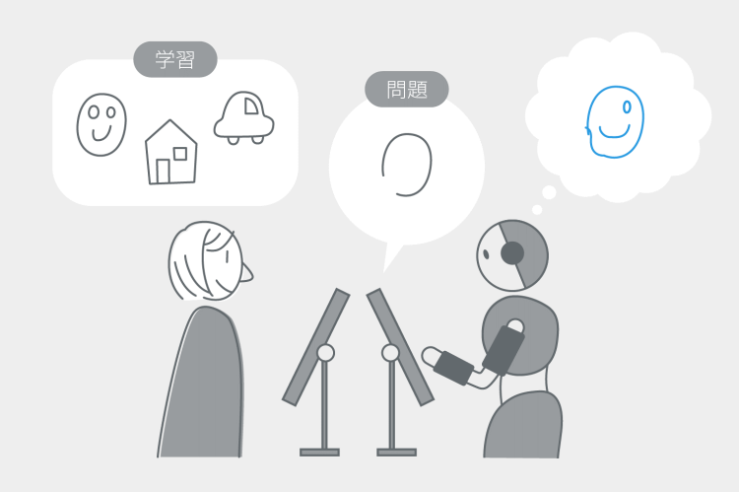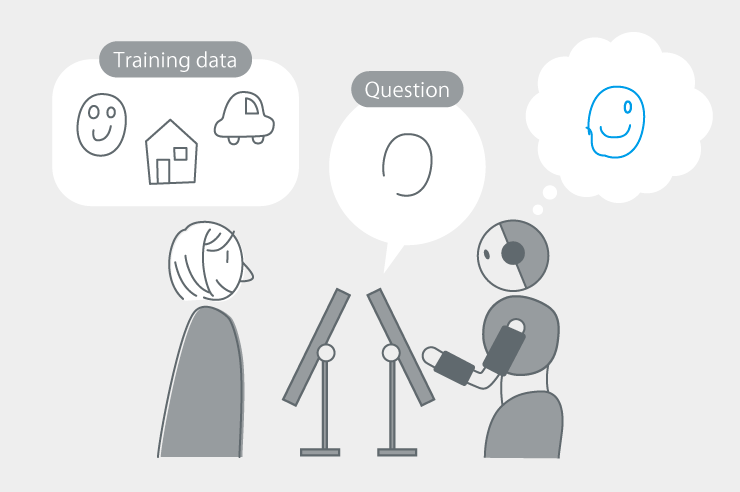Projects 研究プロジェクト
Projects
AI×発達障害当事者研究:計算論的神経科学による認知個性の顕在化 AI x Tojisha-Kenkyu: Computational Neuroscience for Systematic Understanding of Cognitive Individuality
構成メンバー
People
- 研究リーダー Project Leader
-
東京大学 国際高等研究所 ニューロインテリジェンス国際研究機構 International Research Center for Neurointelligence (IRCN), The University of Tokyo
- 研究担当者 Researcher
-
-
 熊谷 晋一郎 准教授 Shinichiro Kumagaya Associate Professor
熊谷 晋一郎 准教授 Shinichiro Kumagaya Associate Professor -
 綾屋 紗月 特任講師 Satsuki Ayaya Project Lecturer
綾屋 紗月 特任講師 Satsuki Ayaya Project Lecturer -
 大黒 達也 特任助教 Tatsuya Daikoku Project Assistant Professor
大黒 達也 特任助教 Tatsuya Daikoku Project Assistant Professor -
 Dalila Burin 特任助教 Dalila Burin Project Assistant Professor
Dalila Burin 特任助教 Dalila Burin Project Assistant Professor
-
Events
Events
- 第40回研究セミナー「脳の統計学習に基づく聴覚認知個性の計算論的・神経生理学的理解」 The 40th Research Seminar: Computational and neurophysiological understanding of cognitive individuality based on statistical learning in the brain
- 第8回 Beyond AI 研究推進機構サイエンスカフェ 動画を公開 The 8th Institute for AI and Beyond Science Café Video is now available.
- 第22回研究セミナー「AIを用いて自閉スペクトラムへのスティグマをどのようにして減らすか」 22th Research Seminar: How to reduce the stigma against autism spectrum condition using AI.
- 第6回研究セミナー 「Developmental and individual differences of drawing behavior: insights from a child experiment and neural network simulations」 6th Research Seminar: Developmental and individual differences of drawing behavior: insights from a child experiment and neural network simulations
News
News
- 【プレスリリース】 自閉スペクトラム症の知覚を体験することで ネガティブな感情が改善される [Press Release] Reduce the stigma of autism spectrum disorders by incorporating the experience of simulated autistic perception
- [受賞]長井志江特任教授が世界のロボティクス分野で著名な女性研究者に与えられる国際的賞WiRESを受賞 [Award] Project Professor Yukie NAGAI awarded the “Women in Robotics Engineering and Science (WiRES)” at IROS 2022
ビデオ
Movie
課題
Challenges
発達障害を個性と捉える「ニューロダイバーシティ社会」の実現 Building a Neurodivergent society that embraces developmental disorders as individuality


自閉スペクトラム症などの発達障害は神経活動の正常な変動の結果として現れるものであり、個性と捉えられるべきとする「ニューロダイバーシティ」の概念が、1990年代後半に提案されました。発達障害と診断される児童の割合が急激に増加する中で、ニューロダイバーシティ社会の実現が望まれています。海外では発達障害者の個性を活かした雇用により急成長する企業が現れる一方で、日本での知的・精神障害者の就労率は6.2%(2015年厚労省)にとどまっています。その理由の一つとして、発達障害者の困りごとや特異性が本人にも周囲にも見えにくく、合理的配慮や社会環境の整備が進まないことが挙げられます。
The concept of “neurodiversity” was proposed in the late 1990s, suggesting that developmental disorders, such as autism spectrum disorder, appear as a result of normal fluctuations in neural activity and should be regarded as individuality. With the rapid increase in the number of children diagnosed with developmental disorders, a neurodivergent society is becoming desirable. Overseas companies are rapidly growing by hiring people with developmental disorders with focus on their personal characteristics while the employment of people with intellectual disabilities / mental disorders in Japan is only 6.2% (Ministry of Health, Labor and Welfare, 2015). One reason for this is that the difficulties encountered by people with developmental disorders and their uniqueness are not visible, both to them and those around them, leading to slow progress in rational consideration and the establishment of social environments.
研究の内容
Details of Project
人工知能と発達障害当事者の双方向からアプローチ Two-way approach from AI and people with developmental disabilities
本研究では、人工知能を用いる構成的アプローチと発達障害当事者を対象にした解析的アプローチという二つの研究手法を融合することで、発達障害という認知個性をより定量的に評価し、これまで本人や周囲に見えにくかった特性を顕在化させることを目指します。人工知能研究では、脳の神経回路を模した計算モデルを設計し、発達障害が生じる脳の状態を再現することで、認知個性をシステムとして捉えます。一方で当事者研究では、発達障害を持つ当事者が自身の困りごとを客観的に観察・分析することで、その背後にある機序の理解を試みます。
In this project, we aim to evaluate developmental disorders as cognitive individuality more quantitatively by integrating a constructive AI-assisted approach and analytical approach targeting persons with developmental disorders. This will help visualize characteristics that have almost been hidden from both the individuals with developmental disorders and those around them. We will design a computational model using AI that mimics the neural circuitry of the brain and reproduce the brain state in which developmental disorders occur, in order to understand cognitive individuality as a system. Under the tojisha-kenkyu project, we will attempt to understand the mechanisms behind developmental disorders by objectively observing and analyzing the problems of individuals with developmental disorders.
【1】AIで脳内の神経回路を再現する [1] Recreating neural circuits in the brain with AI
人工知能研究では、私たちの脳が持つ「予測符号化」と呼ばれる原理を再現した神経回路モデルを用います。私たちの脳は、感覚器官から限られた情報しか得ていないにもかかわらず、過去の体験から獲得した経験や知識と合わせることで、未知な状況に対して予測を立てて行動することができます。これを可能にする有力な仮説として、予測符号化原理が提案されています。計算機上に脳のモデルを構築し、内部のパラメータを変化させることで多様な状態を作り出し、脳の器質的もしくは機能的な疾患をシミュレーションします。このように条件を変えながら、さまざまな認知行動を学習・生成することで、発達障害が生じるメカニズムを構成的に検証します。
In the AI research, we will use neural circuit models that replicate the principle of so-called “predictive coding” in our brains. Our brains can predict and act on unknown situations by combining the limited information we receive from our sensory organs with the experience and knowledge we acquired from past events. The predictive coding principle has been proposed as a promising hypothesis to make this possible. By constructing a model of the brain on a computer and varying its internal parameters, a range of conditions can be created to simulate organic or functional brain diseases. Accordingly, we can constitutively investigate the mechanism of developmental disorders by learning and generating different cognitive behaviors while varying the conditions.


【2】当事者の視点から客観的に分析する [2] Objective analysis from the perspective of parties involved
一方で当事者研究では、発達障害当事者が日常において経験するさまざまな認知行動の困りごとを内部観測者の視点から分析し、それぞれの困りごとに共通する機序を抽出します。さらに、人工知能研究から得られたモデルと照らし合わせることで、認知個性を説明する因子やパラメータを発見します。その結果、個性の発生原理をシステムとして捉えることで認知個性を顕在化し、個性の意識的な制御を目的としたニューロフィードバックやバイオフィードバック(計測される神経活動や生体情報をもとにリアルタイムに状態を推定し本人に伝える手法)の基盤技術の開発につなげます。
On the other hand, in the tojisha-kenkyu project, we will analyze various cognitive behavioral problems experienced by people with developmental disorders in daily life from the perspective of an insider observer and extract common mechanisms behind each problem. By comparing the results with models obtained from our AI research, we will uncover factors and parameters that explain cognitive individualities. As a result, we will elucidate cognitive individuality by revealing the principle of individuality generation as a system and develop fundamental technologies for neurofeedback and biofeedback (a technique for estimating the state of the individual in real time based on measured neural activity and biological information and communicating it to the individual) aimed at the conscious control of individuality.
価値・期待
Values / Hopes
発達障害者の社会参加に新たな指針を与える New guidelines for the social participation of people with developmental disorders
認知個性が顕在化しそのメカニズムが明らかになることで、教育現場での支援・療育、就労現場での雇用・育成、医療現場での診断・治療に新たな指針を与えることが期待できます。従来の事例ベースの支援では対応できなかった個人間の多様性の問題に対して、原理に基づいた支援方法を設計することが可能になります。特に、顕在化された認知個性をニューロフィードバックやバイオフィードバック技術に応用すれば、認知個性を意識的に制御することも可能になります。これは、発達障害者だけではなく定型発達者にとっても有用な技術となり、ニューロダイバーシティ社会の実現に大きく貢献します。
By revealing cognitive individuality and understanding its mechanisms, we can expect to provide new guidelines for support and rehabilitation in the educational field, for employment and training in the employment field, and for diagnoses and treatments in the medical field. It will allow the design of principle-based support methods for diversity issues among individuals that could not be addressed by conventional case-based support. In particular, the application of neurofeedback and biofeedback technologies to revealed cognitive individuality will eventually enable the conscious control of cognitive individuality. This will be a useful technology, not only for people with developmental disorders, but for those with regular development and will contribute immensely to the establishment of a neurodivergent society.
成果
Research outcome
本研究では、認知個性を構成的アプローチから探る人工知能研究と、当事者の視点から解析的に探る発達障害当事者研究を融合することで、「認知個性の発生原理の理解」と「認知個性の顕在化システムの開発」を実現しました。
当事者研究では、認知個性の発生原理として注目する「予測符号化」理論に基づいて、仮説検証型の当事者研究を新たに設計し、実施しました。まず、当事者研究会で得た膨大な語りのデータのテーマ分析と自閉スペクトラム症に関する先行研究のレビューを行い、仮説を定式化し、新たな質問紙を開発・運用しました。また、コミュニティの拡大による原理仮説の精緻化を目的として、当事者が自らのエピソードをオンラインで提供・検索できる当事者研究エピソードバンク(https://token.episodebank.com)や、当事者研究のノウハウをオンラインで学ぶことのできる当事者研究導入講座(https://www.utokyo-ext.co.jp/ids/top)を開発しました。これらの取り組みはすでに多くの企業に導入され、職場の心理的安全性の改善やインクルージョンの向上に貢献することが示されています。
人工知能研究では、脳の機能を模した神経回路モデルを用いて、多様な認知個性が「予測符号化」処理におけるパラメータの変動によって、統一的に説明できることを明らかにしました。例えば、予測信号と感覚信号の精度のバランスが不均衡になることで、学習過程で新たな経験を取り入れることが難しくなり、偏った内部モデルを形成したり、特定の経験に対して過学習を生じることで、汎用的な内部モデルを形成しにくくなることを発見しました。このことは、両極的な特性をもつ感覚過敏と感覚鈍麻が、脳の特定の機能の変調により、表裏一体として生じうることを示唆しています。また、モデル研究で得た仮説を検証するため、子供や成人を対象にした描画課題や作曲課題を実施し、そこに現れる個性が上記のパラメータ変動によって生じることを確認しました。さらに、言語能力や発話、触覚や視覚などの知覚課題においても、予測符号化処理の変動が認知個性を説明しうることが示されています。
当事者研究と人工知能研究で得た知見は、認知個性を顕在化するシステムのプロトタイプ開発に役立てられました。スマホアプリやVR(仮想現実)、ロボットなどを用いて、ユーザが認知個性を可視化することで、企業での当事者研究と同様に、インクルージョンの向上とニューロダイバーシティ社会の実現に貢献すると期待できます。
This project has integrated two approaches to explore cognitive individuality: AI research, which investigates individuality from a constructivist approach, and Tojisha-kenkyu, which analytically examines it from a first-person perspective.
Tojisha-kenkyu has involved a new hypothesis-testing type of research based on the predictive coding theory. We conducted a thematic analysis of narrative data obtained from Tojisha-kenkyu meetings and reviewed existing studies on autism spectrum disorder to formulate a hypothesis and develop new questionnaires for later studies. To expand the community and further refine the hypothesis, we established the Tojisha-kenkyu Episode Bank (https://token.episodebank.com) and the Introductory Lecture on Tojisha-kenkyu (https://www.utokyo-ext.co.jp/ids/top). The former enables users to provide and search their own episodes, whereas the latter enables them to learn how to conduct first-person studies. These initiatives have already been implemented in many companies and shown to improve psychological safety and inclusion in the workplace.
In AI research, we have developed neural network models that imitate the functions of the human brain and demonstrated that diverse cognitive individualities can be explained by modifications of specific parameters in the predictive coding processing. Our findings suggest that an imbalance in the precision of predictive and sensory signals can lead to learning difficulties or overlearning for a particular experience, resulting in unstructured or biased internal models. This result implies that hypersensitivity and hyposensitivity, which have bipolar characteristics, are inextricably linked due to modulations of a specific function in the brain. We have also designed and conducted drawing and composition tasks with children and adults to test the hypothesis obtained in the model study. Our results demonstrated that parameter fluctuations as described above cause the individuality appearing in these tasks. Our further experiments showed that variations in the predictive encoding processing can explain cognitive individuality in various cognitive behaviors such as language ability, speech, and tactile and visual perception.
The above findings from Tojisha-kenkyu and AI research have enabled us to develop prototype systems that manifest cognitive individuality. Users can visualize their cognitive individuality by using smartphone applications, virtual reality, and robots. We believe that these systems will contribute to the improvement of inclusion and the realization of a neurodiverse society, in the same way as Tojisha-kenkyu at companies.
※詳細については、以下URL(PDF)をご参照ください。
https://beyondai.jp/contents/wp-content/uploads/2023/05/AIxTojisha-kenkyu.pdf
※For more detail, please refer to the URL below.
https://beyondai.jp/contents/wp-content/uploads/2023/05/AIxTojisha-kenkyu.pdf

